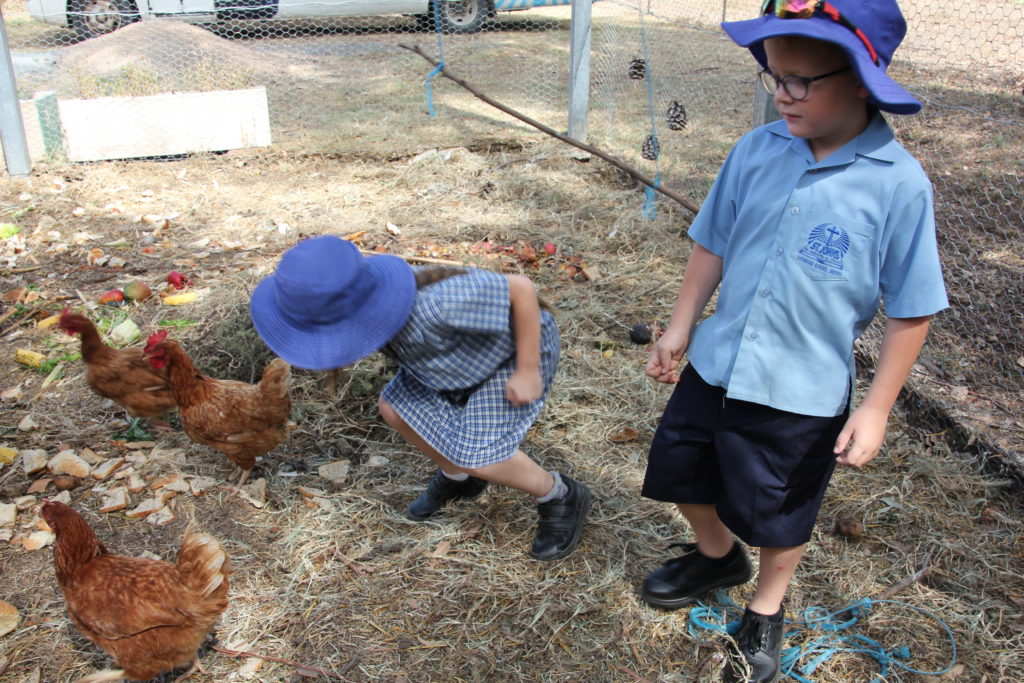

Many schools have school vegetable gardens these days and there is also now a focus on environmental issues. I am lucky to be involved in a great little school – St John’s Lutheran Primary School, in Jindera.
About 3 years ago, the school installed a chicken coop (Cluckingham Palace) and started working towards establishing a kitchen garden. The food scraps from school lunches are gathered each day and fed to the chooks who express their gratitude by laying eggs that are then sold to teachers and parents or used at the school.
Last year when my little person started school I began volunteering for an hour or so each week in the kitchen garden. A variable number of kids join me each week and we work on different projects with a focus on growing food. We gave ourselves the name “The Garden Gang” and it is a pretty cool gang to belong to. I am not the gang leader by the way, I am just the responsible adult who facilitates the gang’s activities and finds the resources for them. The members of our little gang can tell you all about compost with a focus on Pooh! (they are in primary school remember!)
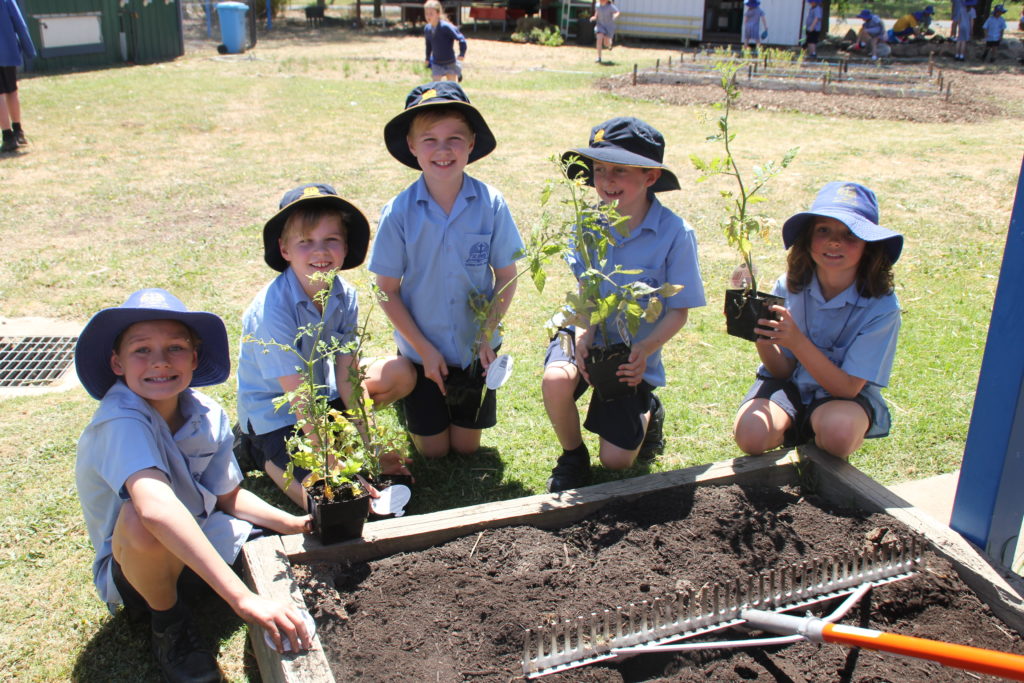
We make our own fertiliser – Pooh Tea – with the droppings from the chicken coop. The boys particularly enjoy giving it a stir and commenting on the slightly odoriferous contents. Some of the girls come just to enjoy a hug with the chooks and I am certain some of the chooks just love their weekly hugs. Each week the worm farm is checked and the worm wee is put out on the vegetables. One of the major events each week is the inspection of our growing vegetables and the harvest and tasting that goes along with that. Radishes were popular but the carrots (that are never going to make it beyond baby size) rule supreme. We pick a couple of buckets of greens and weeds to give to the chooks and worms and generally have a lot of fun. Some of the older boys (10 years old) work incredibly hard each week digging, moving soil and compost, constructing frames for vegetables and building scarecrows.
The learning that happens in the short period of time each week is amazing. Problem-solving skills come to the fore as they learn how to construct what they need from found items. We have had failures along with our successes but that is what gardening is all about. We talk about our successes and failures and how we can do better next time. We have learned about beneficial insects and about those that destroy our hard work. We use natural methods of pest control and work on making sure our soil is healthy and our plants are strong. The best bit about Garden Gang is the enthusiasm these children have for our environment and the joy with which they learn how to grow their own food. Saving and sowing our own seeds has also been a wonderful learning opportunity and their pride in growing plants from seed they harvested is wonderful to witness.
The Year 5 and 6 classes commenced learning in a different way this year using a Project-Based Learning Style. The first project they undertook focussed on the environment and sustainability. The students worked in small groups of 4 or 5 and researched both issues and then formulated responses to the issues. I met with three of the students for a chat about what they learned. I was impressed with their enthusiasm and excitement about their projects and the way they were able to present what they had done to me. Each small group came up with different ideas that they then put into practice and some of these practices are ongoing and having a beneficial impact within the school.

One of the ongoing projects is Nude Food days where the rubbish from each child’s lunch box is counted on a specific day each week and a tally is kept for each class. The students aim to reduce the amount of single-use plastic brought to school and are putting pressure on their parents to help with this. One of the girls I spoke with told me that her mum was already packing nude food and using beeswax wraps before the project commenced but she was in the minority. Others told me how they were able to find suitable small containers at home to replace plastic wrap and they didn’t need to buy any new items. The kids are not perfect (there is still litter on the ground after lunch break) and the lunch boxes (so they tell me) still contain too much single-use plastic but they count that amount and are aiming for a reduction. The conversation that occurs around plastic and litter is another learning opportunity for them. The students are now aware of the impact of their practices on their environment.
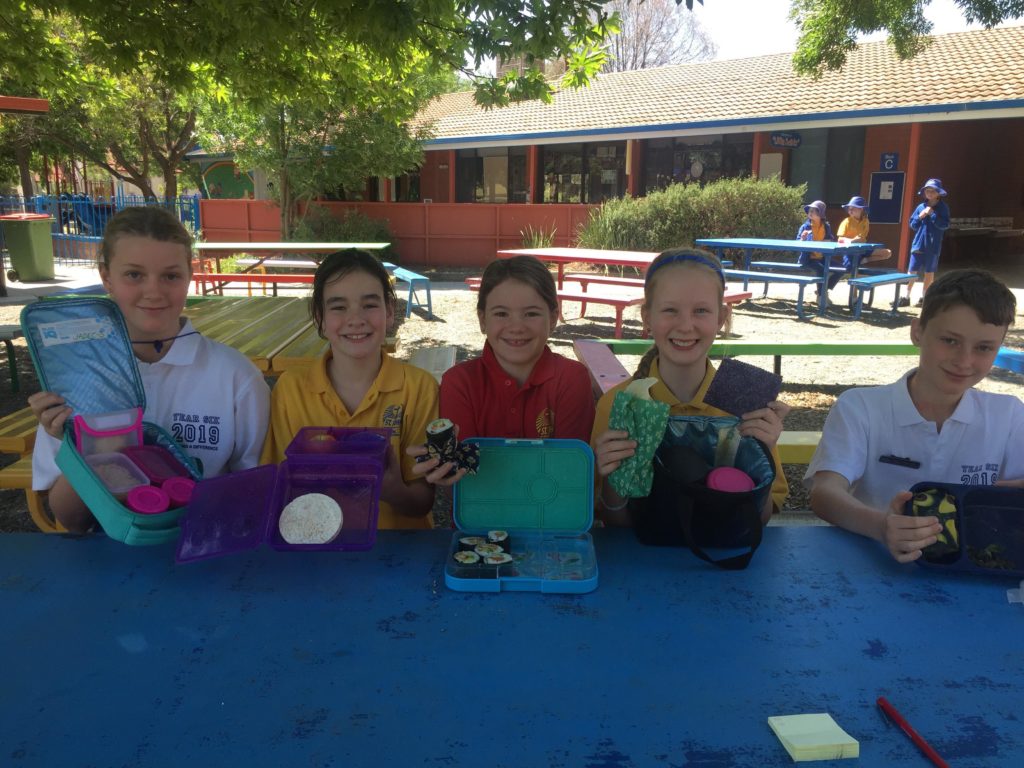
The students also produced some of their own products, learning how to make and package beeswax wraps and reusable shopping bags. One group purchased metal straws in response to finding out how many plastic straws are polluting our environment. The straws, bags and wraps along with some other products were sold by the students to the other students and their families. As a result of their sales the students raised some money and decided that they would put that money into caring for the environment of their school. A compost tumbler, worms for the existing worm farm, seeds and other equipment were purchased and are being used at the school.

It is unrealistic to expect everyone to be 100 percent environmentally sustainable but if each one of us does just one thing differently the impact will be huge.
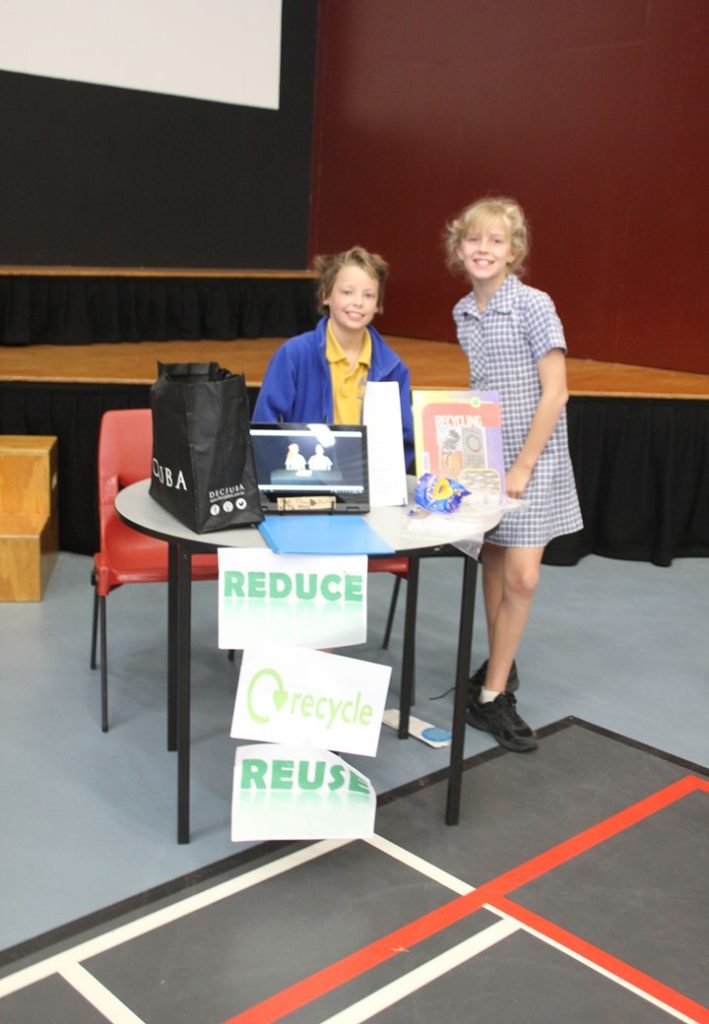
The students at St. John’s and many other primary and high schools are leading the way in taking responsibility for their environment – one that they have the ability to change for the better. We as adults need to join them and get on board in the reduction of single-use plastic.
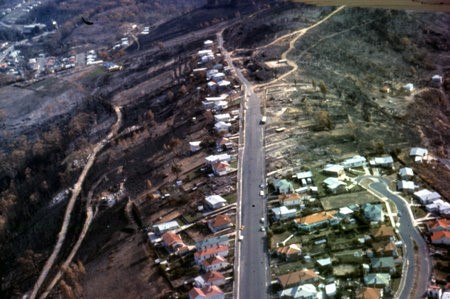
After the fire events of the past week in particular and the past couple of months, I have decided to share a very personal fire story.
On February 7th 1967, I was four years and six weeks old, too young in many people’s opinion to remember too much but believe me, I remember everything that happened that day. We lived in Hobart, Tasmania. It was my first day of preschool and my sister’s first day of primary school. I came home on the bus (the teacher put me on the bus at the preschool end and Mr Dufty made sure I was safe during the very short journey) which was not unusual in those days as men still caught the bus home for lunch and usually my Dad would have been on the bus too but he was away on an Army Reserve camp. Mum collected me off the bus and I clearly remember her saying look at those dreadful fires at Lenah Valley, I didn’t see any fires as I was looking the wrong way towards South Hobart. It was a stinking hot day and I spent the afternoon changing outfits to match those of our next-door neighbour as I played outside. Mum left my eleven-month-old baby brother, toddler sister and I with our neighbour, Ha (and the way she got that name is a whole other story) while she went to pick up my sister from school. (Figure 1 An aerial image of our road after the fires.)
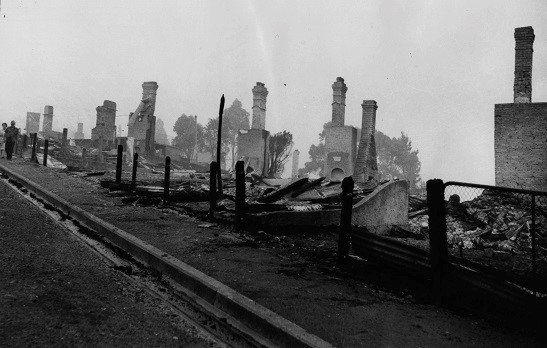
Mum returned about 15 minutes later to find us sitting on Ha’s front lawn with Aunty Sheila (one of those not biological aunts) and her toddler. Our house was right next to a bush reserve and the reserve was on fire as was our house. Mum did not have her purse with her and tried to get into the house to grab some valuables and let the cat out, but the heat was so intense that she couldn’t get to the door. We all crammed into our Hillman Hunter car (tiny little thing), 3 adults and 5 children and down the hill we raced to the Goulburn Street Primary School. The school hall had become an evacuation center and there we sat on the floor. Every time the door opened smoke and dirt blew in. The hall was full of women and children who had no idea if they still had a house or not. Everyone was distressed and I mean really distressed. As the day became evening news would filter in and people were told time after time that their house was gone. On our side of the road, ten houses were destroyed and on the other side it was more hit and miss but many houses went. At some point in the evening, some friends arrived and took us to their house -our house no longer existed. Mum left a note on the door in case Dad went there as she was unable to get in touch with him. The Mills family were wonderful to us. We had nothing except was we were wearing, I had on shorts and a top, my older sister her school uniform and the toddler and baby were in just a nappy. I vividly remember waking up in the middle of the night and my father was there, he and another man from the area had gone AWOL from the army camp to find their families. In the following weeks my Dad and the other man faced a court-martial for their actions but after a public outcry, the charges were dropped. I didn’t know any of that until much later but imagine the stress that added to my parent’s hugely distressed lives.
The following day my parents took my sister to school (St Mary’s College in Hobart) to tell them that they would be taking my sister to the state school as there was no way they could now afford the fees with me needing to start the next year and the other two following after. The nuns told my parents that all fees would be waived until they could afford it and they meant it! We were charity students for many years. As well as that they allowed me to go to school for that week as the preschool was closed and they knew my parents would be busy. They also provided us with lunch for that week. I had a great time at school and was thoroughly put out when I wasn’t allowed to continue and had to wait one whole year before I could really start.
I had a doll just one doll called Topsy. She was a black baby doll and the seam in her head had split a little, so she was held together with Elastoplast (I have one photo of me with her in my arms). I loved that doll and I cried for the next week as she was lost, I also cried for the cat and just cried a lot in general. Marie Mills had just started High School and she and her friends spent a week trying to find me a black baby doll. They found me a black doll, but she wasn’t right and although I still have that doll, I cried some more.
One week after the fires we moved into emergency accommodation with the Toohey family who we lived with for 6 weeks. In the room that my sister and I were to share were twin beds and on each bed was a baby doll -one of them was black and she was perfect -my new Topsy. Of course, I have my Topsy doll to this day, and she has travelled all over Australia with me. That doll means so much to me that I really can’t put it into words.
After 6 weeks we moved in with my Grandfather -poor man went from Batchelor working shift work to being a family man with two other adults and four very damaged children in his house that had an outside toilet and two power points in the whole house. But he had a television which we had never had! We lived with Grandpa for 8 months while our new house (on the same site as the old one) was built.
We were given everything that we needed. I recall going to a charity centre and seeing a rocking horse which we were then given, it still lives at my sister’s house and has been loved by a whole new generation of children. Our swing survived but the seat was burned so someone replaced the seat for us. A woman who my parents had never met bought my sister all the uniform items that had been lost and each of us a piece of clothing. One of Mum’s friends sent 3 little blue corduroy pinafores with red cardigans to match. I have another sister born 18 months after the fire and that poor child wore those pinafores and cardigans year after year.
The point of me telling this story at this time is to point out that an event like this changes you forever. We didn’t receive counselling (just not available then) which is something people today have access to thankfully. My older sister has never spoken about that day and fifty years later still refuses to talk about it. My younger brother and sister don’t have actual memories, but they were still emotionally damaged. My mum never really got over the whole event. Anxiety became something we just lived with. We always had a go-bag ready during summer with the one photo album we had of our baby years (my uncle gathered all the photos my mum had sent to family and put them in a beautiful red leather album which is now in the custody of my sister). Our family history is divided into pre-fire and post-fire. We have no family heirlooms, no baptism dress or family treasures other than my Mum’s engagement and wedding rings. Material possessions can be replaced but nothing is ever the same. The smell of bush fire smoke instantly throws me into severe anxiety. I have a Jackie French book that I was given for Christmas two years ago, but I can’t read it as it is about bush fires. I can’t watch news footage of fires. The thought of people driving past fire scenes for a look makes me incredibly angry. Don’t get me started on looters.
I am a hoarder and I know why! If you lose everything it becomes very hard to get rid of things!
If you know people impacted by fire, have patience, know they are grieving and will for a long time. Don’t use platitudes like at least you are alive -they know that but won’t be feeling lucky in any way. Listen if that is what they need. Give what you can.
Many years after the fire my Mum was talking to a bus driver at our closest bus stop and he told her how in 1967 he had dropped a little girl off at that stop and he had never been able to stop thinking about her and what had become of her on that awful day. Mum was able to tell him that I was that little girl and I was alive, well and rebellious. People who are in the periphery of a disaster suffer too.
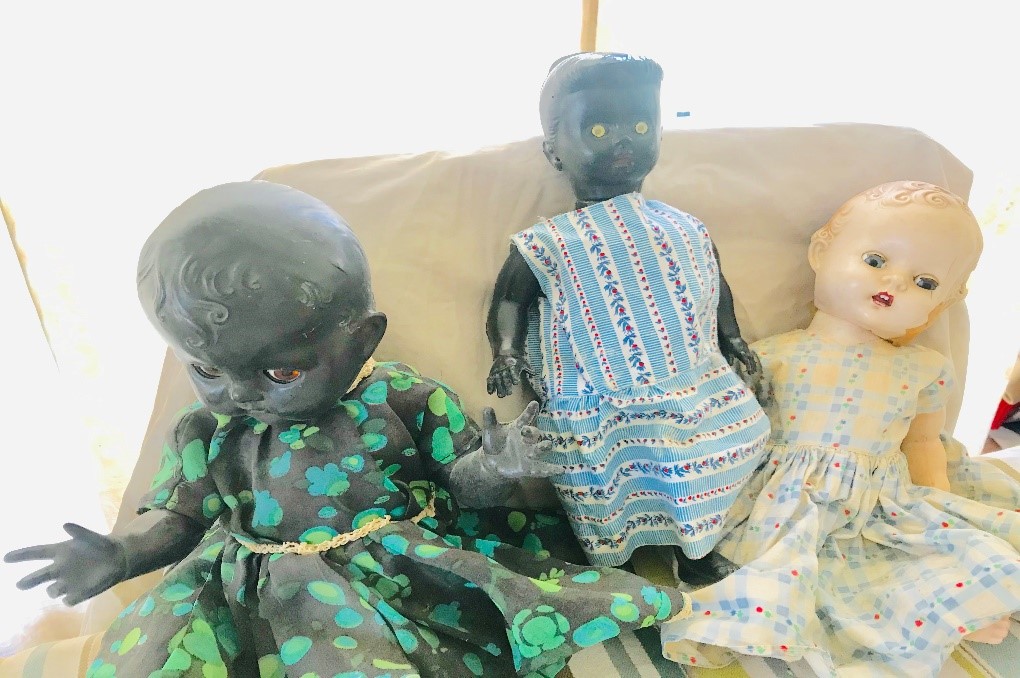
The loss of a doll can represent the loss of everything!

When I need to buy an article (we are not talking a new washing machine here) there are a number of things I do prior to forking out cash to buy it from a shop or off the internet. If, for example, I’m looking to buy honey I want to know that it is real honey and not the one that’s watered down with sugar syrup and colourings. I prefer to buy honey that is local, so I would look at where it is possible to get it in my local area. It may well be that I’m able to barter something I have such as eggs. Homemade sauce or jam, vegetables or plants for a jar of honey. If I’m unable to barter for the honey I need I will investigate if there are farm gate shops selling their honey or it may be possible to find a local shop that sells on behalf of a beekeeper.
Barter is an age-old system that has become less mainstream in our money-driven economy. Some people feel embarrassed to even make an enquiry about the possibility of bartering, but such enquiries may be met with happiness and if not, nothing has been lost and cash can always be produced. Bartering is a fabulous form of local trade and it is possible to barter for many things. If you have a skill that you can put to use for someone or are able to provide goods or a service, it is quite possible that you can barter. I have bartered childcare for freshly baked bread, eggs for dance lessons, sauce and vegetables for honey. My husband shears Alpacas and he has bartered shearing for a new ram, local olive oil and lambs which we have then raised and consumed at a later date.
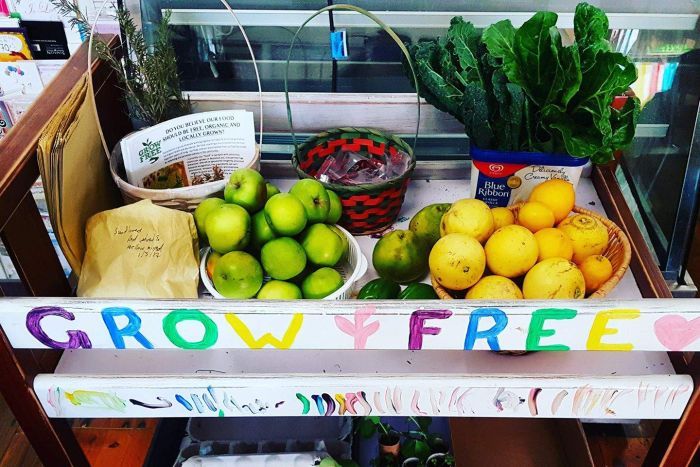
Swapping like for like is another local form of economy. The Grow Free Movement has made swapping popular again and has carts at various sites where you can put excess plants, vegetables, seeds and cuttings and take what is on the cart in return. No one mans the carts or monitors what is given or taken, it is all done on an honesty system. You can find a local Grow Free cart via social media. There are local food swaps that occur at different venues as well and these are a great source of vegetables and plants. A local swap that I have attended even has poultry involved and I have said goodbye to a couple of roosters via this method. Belonging to a local group on social media can give you access to a plentiful supply of items that people no longer need or have an excess of.
As a child, I can remember my mother receiving calls from various friends telling her their fruit was ready. The tribe would then be loaded into the car with buckets and put to work picking fruit -plums, apricots, cherries, peaches and nectarines, which would then be bottled or made into jam with some of the jam being given to the owners of the fruit trees. The owners were happy that the fruit was picked and not left to rot on the ground and they also scored fresh home-made jam. There was an old cupboard in the corner of my fathers’ workshop that housed the bottled fruit and jam. These were eaten throughout the year with whoever was sent to get a bottle of fruit being able to pick their favourite. Apricots were my favourite and also the first to be finished. By the end of winter, there were often only bottles of plums left, obviously no one’s favourite.
If I am not able to barter for or swap an item that I require, my next choice is to buy as local as possible particularly for food items so that I know they are fresh and have low food miles.
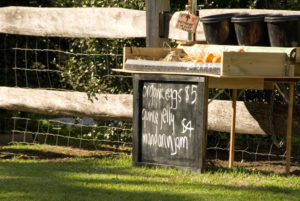
In many rural areas, there are farm gate stalls that have excess produce on them for sale, often via an honesty system. This is a great way of getting fresh local produce and supporting farmers and fruit growers. In a past life, I would drive to Griffith once per month and I would always drive past the farm gate stalls to pick up some great produce which could include watermelons, pumpkins and oranges depending on the time of year. I know that in the Huon Valley area of Tasmania there are some wonderful farm shops that sell amazing fruit at great prices. Three or four bite cherries are my particular favourite if I’m there at the correct season. What can be better than eating fresh produce that has usually been picked that day. If I’m going to buy fruit, this would be my first choice if available.
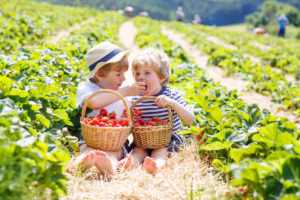
I cannot grow berries! I don’t know why but I kill them each and every time I plant them. I figure that I can’t be self-sufficient anyway as I don’t know how to make shoes, so I let someone else grow the berries for me. Every year we go on a drive to Stanley and pick kilos of berries and their cherries too if they are available. It has become a tradition that a friend and I go each year, the time varies depending on the season we are having but the trip is always made. After getting the berries home they are either frozen immediately for use throughout the year or are made into ice cream, jam and sauces. Berry season should be with us in about 6 weeks and I am looking forward to it as my berry store is finished for the year. I do not buy berries from the supermarket as they tend to come from other areas and I refuse to buy frozen berries, particularly after recent scares around contamination issues. My annual visit puts dollars in a local farmer’s pocket, and I know where the product is grown and how many food miles are involved.
I do buy mangoes, avocadoes and pineapples from shops as my alternative is not to have them or to move further north.
For non-food items, I also try to buy from local producers if at all possible. A shop recently opened in Wodonga (That Little Place) and their point of difference is that they stock products from local producers and artisans. There are often small art galleries that have the works of local artists (not limited to paintings) where you can find unique pieces across many price ranges.
Another amazing recent social media initiative is the Facebook page One Day Closer to Rain (Drought) – Rural Cottage Crafts. This group is national and showcases the works of rural people across Australia. There are a huge array of beautiful items available and your money is supporting rural small businesses.
Before pulling out your wallet or purse and buying from large chain stores and supermarkets, please think about your shopping practices and investigate what there is in your area and the local businesses you could be supporting. Don’t be embarrassed to barter or visit local swaps or Grow Free carts, you may be missing a fabulous opportunity.
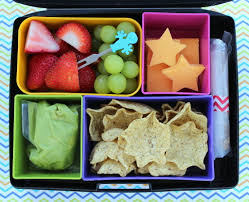
It is the time of year when people are getting organised for their little one to start school next year. Orientation days are occurring, and little people are either excited beyond belief or filled with trepidation. Parents are starting to think about uniforms and school bags along with lunch boxes and drink bottles. The Christmas before school starts is probably the only one that you will get away with school gear being received with excitement. School hat and bag along with a lunch box and drink bottle make a great present. Buying a good quality school bag is a sound investment as it is likely to last a number of years rather than being almost disposable. Plain bags are also a better idea than one covered in the child’s favourite character -you can almost guarantee they will be completely over the character bag in twelve months even if the bag has plenty of life left in it. Uniform bags seem to be good quality and reduce competition for who has the better bag.
School lunches can be the bane of a parent’s life! What to pack, quantities, how to keep it cool and edible are all topics that parents stress over. Many schools have policies around what can and can’t be packed in lunch boxes including nut-free policies. Schools are now starting to engage in the ‘nude food’ trend with items wrapped in plastic being either banned or frowned upon. I have seen many discussions on social media lately about the trend towards nude food – not all positive discussion by any means. Words like “lunch box Nazis” and “plastic police” are being bantered about. I believe that to create change we need to start with children who then put pressure on their parents for positive change. This process is now occurring, and some parents are very resistant to change. This is a very natural part of the process of change but one that seems to take on a life of its own with social media groups bringing the discontent together. Those who are happy about change tend not to engage in the conversation, so it is the negative viewpoint that is heard. Eventually, things will settle, and nude food lunch boxes will be the norm.
The cost of purchasing good quality food containers that last well and stand up to the treatment that children will put them through may seem prohibitive initially, but long-term money will be saved. Kids need to be taught to recognise their own items (good name labels will help with this) and to put their belongings back in their bags so they go home at the end of the day. Expect a few losses occasionally but if it is happening frequently you may need to speak to your child’s teacher to come up with a strategy to prevent it.
There are many different options for school lunch containers these days from thermal-lined containers that you can add a small ice brick to, up to amazing bento boxes and thermos flasks. Washing lots of little containers at the end of the day may not be a super fun task and certainly throwing plastic wrap or bags in the bin may seem like an easier option but the damage all that plastic is doing to the environment is worth the effort.
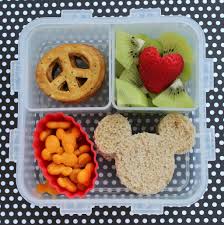
The school my child attends has been auditing the litter in lunch boxes every Wednesday for the entire school year. The litter is counted (this does not include food waste which is put into containers and fed to the school chooks and worms or put in the school compost bin) but empty plastic packets or plastic wrap is counted. My child obviously knows my interest in this area and frequently reports back to me on the number of pieces of litter from his class. One day in the first term of school there were more than 3 pieces of litter per child in the class. I know my child and one other did not have any litter so some of them must have had heaps of pre-packaged food in their lunch boxes. The fact that he is interested and many of his classmates are now engaging in the process gladdens my heart.

I know I have talked about tips to reduce lunch box litter before but it seems a good time to go over it again. Homemade biscuits and snacks are great because you know exactly what goes into them and can control things like the amount of sugar you use. It is also easy to make sure your home-made goodies are the right size for your containers. Bulk baking things like muffins once per month and freezing them is a great idea. In summer frozen items help to keep everything else cool and will be thawed by the time the child is ready to eat it. In our time-poor lives, it may be beyond many people to provide homemade food for school lunches and there are plenty of other options that don’t involve plastic wrapping. Buying food that is not individually wrapped is not difficult and it is easy to put a few biscuits or snacks into a container. The one thing that I haven’t found free of individual wrapping is muesli bars! Fruit makes an excellent snack and things like bananas, oranges and mandarins come in their own very natural wrapping and no need for further containers.
Another issue that occurs at the beginning of each year is the schoolbooks coming home to be covered. I totally get the fact that books that are covered in contact stay neater and last much longer than those that aren’t, but I am a total contact klutz – bubbles and wrinkles just seem to occur no matter how careful I am, I hate hate hate contact and the fact that it is plastic just makes it worse. You will never find my name on a list of volunteers to cover new library books – that is a disaster just waiting to occur. Last year I discovered that someone had invented slip on plastic covers for schoolbooks (I figure it was another contact klutz that came up with the concept). I know they are plastic, but they last for longer than 1 school year and can be removed if the books are being tossed or composted. Sometimes it is a matter of the lesser of two evils. Roll on high school when folders with loose leaf paper are the norm and don’t need covering, just another five years to wait …….. audible sigh!!!!